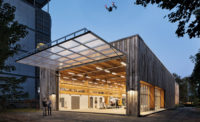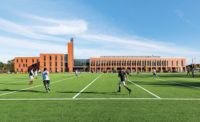Atlanta
Encircled by a stand of towering deciduous trees, Benjamin E. Mays High School keeps a low profile, despite having been home to such notable alumni as visual artist Radcliffe Bailey and musician Cee Lo Green, and currently being the largest school serving grades nine through 12 in the Atlanta Public Schools (APS). When it was built in 1981, the 310,000-square-foot concrete-and-brick structure was a bunker of a school: Low ceilings and winding, windowless corridors made for dark and uninviting interior spaces. It lurked on its hilly site, high above a middle-class African-American suburb.
Elegantly renovated and expanded to 350,000 square feet by Perkins+Will's Atlanta office, a 'new' and more welcoming Mays was completed in January 2012, bringing daylight and air to the school's 1,600 students'all on a tight budget. 'There are some students who'll fall asleep no matter what you do,' jokes Dr. Tyronne Smith, an administrator who's been with APS for 30 years and has served as Mays's principal for 12. 'But most of them, when it's bright and airy and the temperature's good, function better.'
Transparency and a sense of openness were Perkins+Will's first set of priorities, but for budgetary reasons, scrapping the grim old building wasn't a viable option. A statewide penny-on-the-dollar sales tax, called SPLOST, for Special Purpose Local Option Sales Tax, generated only enough revenue for a renovation (which totaled $32 million). So the firm began by demolishing the old building's core, removing the existing cafeteria, media center, and courtyards, and erecting a new steel frame inside the void with a height 7 feet above the original roofline. The design team relocated the main entrance, which previously sat in the center of the rectangular plan, to a space adjacent to the existing theater, and removed support columns and other structural elements to create a double-height entrance hall.
'Before, it was really a rat maze,' says Barbara Crum, who leads the K'12 education-design practice at Perkins+Will's Atlanta office. 'You didn't have these straight-through corridors,' she adds, gesturing down a long, daylit, double-loaded hallway lined with classrooms. Each classroom has views out to the woods beyond the school and clerestory windows into the halls that let natural light in. 'From a security and management standpoint, it's better,' says Jere Smith, director of construction for APS, pointing out that dead-end corridors and a lack of windows could prove hazardous in a variety of emergencies.
In addition to addressing safety concerns, the reorganization supports Mays's curricular goals. The school was named after the prominent civil-rights activist and former president of Atlanta's historically black Morehouse College and, as such, is organized around four collegiate-style 'academies' or 'learning communities.' Students can choose among science and mathematics, business and entrepreneurship, mass communications, and public affairs and administration. 'Each 'house' has an administrative office in the front,' Crum explains; computer labs and other shared spaces, like lecture halls, are centrally located within each learning community, and flexible rooms for instruction occupy the perimeter of the building. Science labs, which require special equipment and storage, sit at the building's heart. The school's robust arts and athletics programs also have dedicated spaces. 'The strings program is huge,' explains Dr. Smith. 'We have 80 kids in the orchestra.'
In the months since Mays reopened, the students have taken a noticeable pride in their new school, Dr. Smith reports. 'We haven't had graffiti,' he says. 'I think the building earns respect'it is more conducive to learning.' But as students amble in the hallways as classes change, with the squeak of sneakers and excited voices rising in the entrance lobby, Smith has a word of advice for the architects' future education projects: 'High-school kids like to congregate, and whenever they drop whatever it is they're eating or drinking, it stains the concrete,' says Smith, referring to the area beneath the entrance canopy. 'I don't know what's in that food, but when it gets into the concrete, it will not come out,' he adds with a laugh. 'What's in that buffalo sauce? I've told some of the kids they should look into it!'
Completion Date: January 2012
Gross square footage: 350,000 square feet
Total construction cost: $32 million
Location: 3450 Benjamin E. Mays Drive, SW, Atlanta, Georgia 30331
People
Owner:
Architect:
Personnel in architect's firm who should receive special credit:
Engineer(s):
Consultant(s):
General contractor: Photographer(s): Jonathan Hillyer
CAD system, project management, or other software used: |
Products
Structural system
Roofing
Windows
Doors Metal doors: Steelcraft Wood doors: Algoma
Hardware Closers: Glynn-Johnson Exit devices: Von Duprin Pulls: Best Access Systems Security devices: Alarm Lock
Interior finishes Suspension grid: Armstrong Paints and stains: Sherwin-Williams Wall coverings: Conwed, MBI Special surfacing: Stonhard Resinous Flooring, Fritztile Resilient flooring: Armstrong Carpet: InterfaceFLOR
Furnishings
Conveyance |











Post a comment to this article
Report Abusive Comment